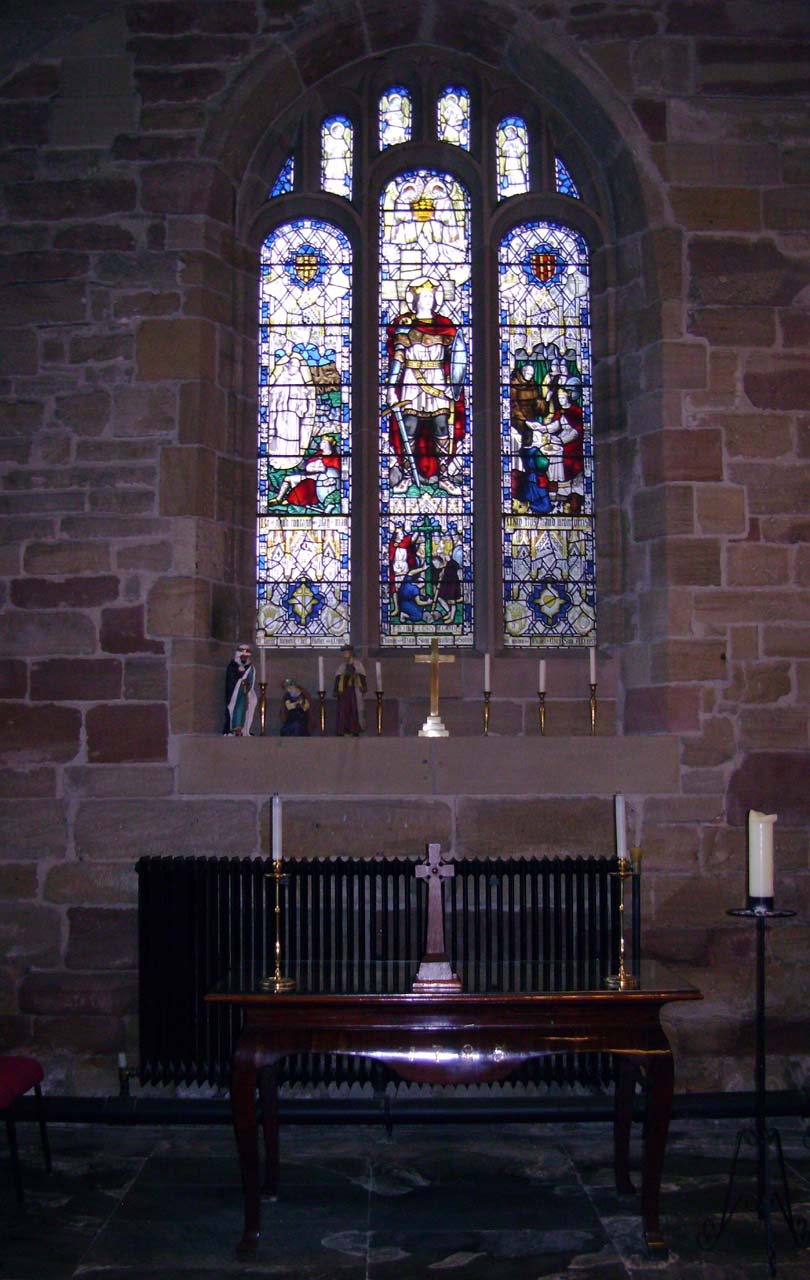 |
The Church of St Oswald, Winwick |
 |
Gerard Chapel
This chapel, probably originally a separate building adjoining the church, was owned as a private chapel by the Gerard family of Ashton, which was then within the Winwick parish. A memorial brass to Peter Gerard who died in 1495 is inset into the floor. It is the oldest brass in the church. It was not until 1928 that this chapel was formally and completely given over to the church by the Gerard family, who had remained loyal to the Church of Rome after the Reformation. The East window of this chapel is the most modern example of stained glass in the church and was given in 1937 by Mary Stone in memory of her parents. In the centre panel King Oswald is seen in full armour, and below, erecting a Christian cross on the battlefield at Havenfield in Yorkshire in 634. On the left Oswald is experiencing a Christian vision, while on the right; he is depicted distributing food and valuables to the poor. |
 | |
Photograph supplied by and © of Frances Holcroft |
The Altar in the chapel is a beautiful example of marquetry and was, until 1849 the High Altar of the church. In that year the Chancel was renovated as it is now, and furnished in oak, so that this wood was not compatible. It was made in 1725 and the Churchwardens’ account book for that year records the purchase: £4 was paid to a Mr. Anderson. It must have been made locally as carriage of only one shilling was charged. At the same time £28/15/7 was paid for a velvet cloth to cover it. Inlaid into the top of the Altar are the initials of the Churchwardens for 1725. The ancient font (on a more modern pedestal) which was discovered in the churchyard in this damaged condition is thought to be of the 14th Century and may have been destroyed in the Civil War period, when St. Oswald’s suffered at the hands of those supporters of Oliver Cromwell who disliked the trappings of the Church of England The portrait above the font is of Richard Sherlock D.D. who was Rector of Winwick church in 1660. |
|
The Celtic Preaching Cross All that is left of an ancient Celtic wheel cross stands on a window cill in the Gerard chapel, only the back is visible for the front was chipped smooth and used as a grave stone in the 18th Century. It is thought to be 1,000 years old and it is likely that it stood on the hill on which the church now stands to mark a Christian place of gathering. When complete it must have stood about 18 feet tall. When it was destroyed and the upright lost is unknown but it may have been in the Civil War period, 1642 to 1649.
Notice the Celtic decoration, an interlacing design, typical of Celtic Christian art, suggesting the principle of constant movement. The endless intertwining ribbons that make up the Celtic knot, like the ancient illuminated manuscripts suggest a world and a faith which is in a state of perpetual motion. On the ends however, there is a much more personal story. On the right hand there is a carving that may represent the martyrdom of St. Oswald, as his body was dismembered by the supporters of the pagan king, Penda. On the left hand end, the carving may be interpreted as thus: the man carrying the buckets may be carrying the water from St. Oswald’s well which is situated in a field about a mile from the church in Hermitage Green, so-called after the hermits whose job it was to guard the well. Copy Marriage Certificate of the Captain of the Titanic In the Gerard Chapel is a copy of a parish register entry which records the marriage of Edward John Smith, better known as the captain of the White Star liner Titanic. Captain Smith married a local farmer’s daughter Sarah Eleanor Pennington from Woodhead farm at Winwick St. Oswald on the 13th January 1887. The Titanic sank on the 15 April 1912 after a collision with an iceberg. Captain Smith along with about 1500 people were lost.
|
| Winwick Home & Contents | ©Lancashire OnLine Parish Clerks | Lancashire Home |